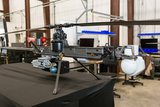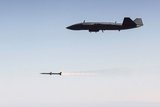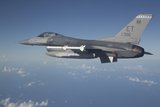BAE Systems puts Tempest virtual design through its paces
Engineers at BAE Systems have been using the digital environment to design, test and fly conceptual models for the Tempest next-generation combat air system.
Using digital twin technologies, conceptual shapes for the UK aircraft have been virtually designed and tested more quickly than ever before, the company claimed on 24 August.
Following extensive digital testing of the concepts and aerodynamic features, 3D printed scale models were put through their paces at the BAE Systems wind tunnel facility in Warton, Lancashire, under wind speeds of more than twice the speed of sound.
Data from the trials will be used to refine and shape the final design of Tempest, which is hoped to enter service by 2035.
The High Speed Wind Tunnel at Warton can consume 15 tonnes of air in 20 seconds when running at full power at subsonic, transonic and supersonic speeds.
As part of our promise to deliver comprehensive coverage to our Defence Insight and Premium News subscribers, our curated defence news content provides the latest industry updates, contract awards and programme milestones.
Related Programmes in Defence Insight
More from Air Warfare
-
![Anduril UK and GKN Aerospace collaborate on British Army ACP bid]()
Anduril UK and GKN Aerospace collaborate on British Army ACP bid
The pair will submit their demonstrator concept for Project Nyx, a development project for the British Army’s Land Autonomous Collaborative Platform.
-
![US Army command’s Picatinny CLIK common lethal drone interface makes progress]()
US Army command’s Picatinny CLIK common lethal drone interface makes progress
The Picatinny Common Lethality Integration Kit is designed to overcome the issue of unique integration methods between lethal payloads and drones as well as avoiding problematic acquisition conditions created by vendor lock.
-
![Australia invests extra A$1.4 billion in MQ-28A Ghost Bat after successful missile fire test]()
Australia invests extra A$1.4 billion in MQ-28A Ghost Bat after successful missile fire test
The investment includes new contracts for six MQ-28A Ghost Bat aircraft, as well as provisional funds to invest in the development of a Block 3 prototype.
-
![US approves potential $4.7 billion missile and air defence system sales to Denmark and Italy]()
US approves potential $4.7 billion missile and air defence system sales to Denmark and Italy
Italy could field the JASSM-ER for its combat aircraft including the F-35, while Denmark has been approved for AMRAAM and an Integrated Battle Command system procurement.
-
![Northrop Grumman to fly new Project Talon CCA by late 2026]()
Northrop Grumman to fly new Project Talon CCA by late 2026
The newly unveiled collaborative combat aircraft looks to strike a balance between capability and cost-effectiveness, according to the company.























